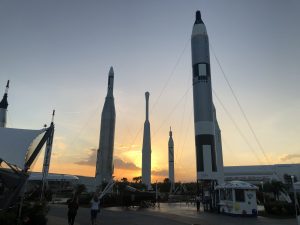Ever since I became fascinated by the space program in my youth, I have wanted to visit the Kennedy Space Center in Cape Canaveral, Florida. Last week, that dream became reality when Martha and I spent a full day there.
I had no idea the KSC is so huge — two hundred twenty square miles, on which the structures are kept far from each other so if something goes wrong in one, it doesn’t impact another. The Visitors Complex is made up of several pavilions dedicated to different parts of NASA’s history, and everywhere you go there’s a running musical theme that sounds like a cross between the soundtracks of “Apollo 13” and “Galaxy Quest.”
Since the Apollo program was NASA’s most successful era — what with putting men on the moon and all — it garners much of the attention, but not all of it. There’s a Rocket Garden that displays missiles from the earliest days of Americans in space in the Mercury and Gemini programs. There’s an Astronaut Hall Of Fame dedicated to the hundreds of astronauts who have been to space. To its credit, KSC doesn’t shy away from the fatal moments that are also part of the space program’s history, with exhibits about the Apollo 1 fire, the Challenger explosion, and the deaths of the Columbia crew. There are video presentations and 3D Imax movies, many of which subtly highlight one big difference from NASA’s earliest days — gender and racial diversity, with a personnel roster now full of more than just white men in white shirts.
There’s an entire building dedicated to the space shuttle Atlantis, with the last of those behemoths fully on display. With its payload bay open and on view, it took my breath away. There were two men who’d worked on the shuttle program answering questions, so I asked how they had solved the problem of getting the heat-resistant tiles to stick to the shuttle’s underside, thus keeping the spacecraft from burning up on re-entry. He surprised me by saying it was as simple as moving the whole thing from California to Florida. It turned out the former’s air was too dry for the adhesive to work correctly, but the latter’s humidity made the glue act and react differently, keeping the seal intact and ready to fly for the inaugural mission in 1981.
We saw a presentation by astronaut Mike Baker, veteran of four shuttle missions, who said that on the first two, he’d only looked back at our home planet through the viewfinder of his camera, but on his third trip, he had to remind himself to put the device down and see it with his own two eyes. He was so enraptured by the view that, while not doing experiments or other work, he’d float over to one of the windows and just look down. As he showed us magnificent pictures of Earth, he remembered thinking how much more peaceful the planet seemed from up there — and how thin and fragile our atmospheric layer is.
We also went on a behind-the-scenes bus tour of NASA’s various launch pads, several of which are still in use, including the two that Elon Musk’s SpaceX has leased and uses regularly. I was especially disappointed that, although they had three launches scheduled this month, there were none on the day we were there. I have watched several of the SpaceX launches with amazement as their first-stage boosters returned intact with vertical landings on drone ships, allowing them to be reused for future missions. So damned cool!
On our bus, the tour guide (“communicator” in Kennedy Space Center parlance) was a man named Steve who had spent 47 years working for NASA or its contractors. He’d been in mission control multiple times, and even got to do the countdown on several launches! Steve was an engineer, and thus obsessed with statistics (e.g. how much fuel the external tanks hold, the speed of the crawler that carries the rockets and towers to the launch pad, the height of the giant flag painted on the outside of the Vehicle Assembly Building), but he shared some great stories, too.
Doug, the driver, brought the bus to a halt a half-dozen times whenever he or Steve spotted an alligator — not unusual considering 95% of the Kennedy Space Center’s land is still a nature preserve. But while everyone else on the bus was thrilled to see and take photos of the gators, Martha would have been happier if they’d stayed much further away. Like, in Kazakhstan, maybe.
The bus tour ended at the Apollo/Saturn V Center, which has a full-size original of the rocket that was NASA’s workhorse fifty years ago. The agency is currently developing a modern-day replacement, the Space Launch System with the Orion crew capsule, which will be used to return humans to the lunar surface just four years hence. That program is called Artemis, named for the Greek goddess and Apollo’s sister.
While the space program always used contractors like Grumman, IBM, McDonnell, and others, today’s NASA is being pushed by companies that work with and challenge it. The KSC personnel we spoke with weren’t shy about discussing SpaceX’s plans to go to the moon (and Mars?), nor the oversized buildings belonging to Blue Origin, Jeff Bezos’ company that will also try to get more humans into space, whether for tourism or scientific purposes.
It’s all incredibly impressive and made for a great day that met and in some ways exceeded my expectations. You can have Disney World and the other fantasy lands in the Orlando area. I was happy to be an hour away in the science-based realities of the Kennedy Space Center.

